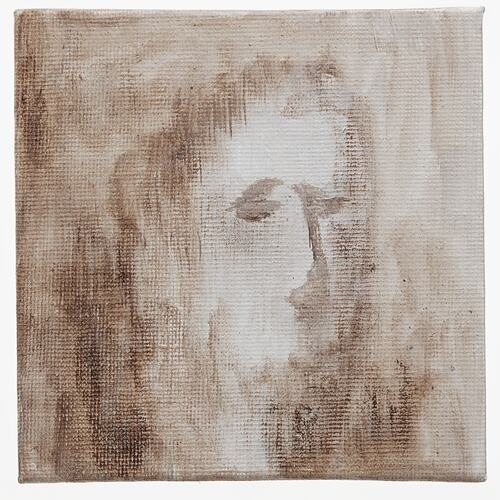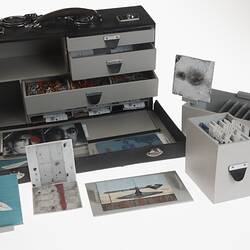Summary
Artwork entitled 'No eye, no mouth, no will', created in 2015 and recreated in 2018 by Melbourne-based Hungarian refugee, Gyorgyi Marek. It is part of 'Attache Case', a collective artwork co-ordinated by Peter Burke in 2015. Gyorgyi also created two other artworks in this collection: 'Disconnected' (HT56009.14) and 'Relying on others mercy' (HT56009.15).
Artist statement provided by Gyorgyi in 2021:
''I left my homeland, Hungary, at 29 with my husband and our two small children. Life was tough as we tried to create a new existence for our family. It was not until my early fifties when pursuing a lifelong dream to be an artist, that I completed my visual art degree at Victoria University and an overseas semester experience at Vancouver Island University in Nanaimo, Canada. Prior to that, I had a career in fashion, working as a designer and seamstress. I'm passionate about beautiful natural fabrics, papers, paint and creating something with them. I suffered anxiety all my life, along with many stressful events. When I finally looked at how to deal with this, and better manage my life, I became interested in art therapy, energy healing and meditation. I currently work part time as an artist in my studio and part time as a service provider for NDIS. My work helps me to stop, pay attention to my life and the world around me. I found my place where I belong.'
'What was it like, leaving my homeland and arriving in a different world?
First image: I represented a characterless, foggy portrait of a refugee. In a refugee camp you become a number, and no one sees your face.'
'Second image: flying to our new home Melbourne along with other refugee families on board, there was a small child asking her mum: "Mum, when will we get home? I want to go Home". I will never forget those moments. Those few words stay with me forever.'
'In the third image I try to explain how we felt in the "new" land after arriving. A vulnerable foetus who got disconnected from her mother tries to survive. You don't know anything about this land, you need to be "born again": make a living, learn a new language, a new culture. You are only a small, vulnerable living creature, physically distant from your past.'
This collective artwork, entitled 'Attache Case' (HT56009), was created by Melbourne artist, curator and lecturer Peter Burke in 2015 as part of an international touring art installation, 'Low-Cost Diplomatic Bag', auspiced by the Spanish Embassy, and curated by Nilo Casares and ArtEx Madrid. It travelled to the Spanish Embassies in five countries, including Australia, in 2015-2016 (one venue included Immigration Museum, Melbourne). 'Attache Case' is comprised of a re-purposed doctor's medical case which opens to reveal small drawers containing 41 individuals' miniature artworks representing 21 refugees from Afghanistan, Vietnam, Poland, Colombia, Hungary, Sri Lanka, Iran, Egypt and Iraq.
The artworks inside the case are acrylic and oil paintings and collage works on canvas board and copper. Many artworks have handwritten descriptions on paper by the artists on the reverse. The collection also includes a video about the project by César Espada produced in 2015.
Physical Description
Acrylic on canvas board. Outline of a face in sepia tones.
Significance
'Attache Case' is a collective artwork created in 2015 in response to an invitation by artist, Peter Burke, to a number of asylum seekers and refugees in Melbourne to express their experience visually. The refugees and asylum seekers (some in detention at the time of the project) who produced the artworks came from diverse countries including Afghanistan, Vietnam, Poland, Hungary, Colombia, Sri Lanka, Iran, Egypt and Iraq. They explore diverse themes relating to detainment, immigration, border security policies, bureaucracy, and mental health.
The artists convey thoughts and feelings about freedom, opportunities, life in Australia, resettlement, optimism, despair, grief, hope, fear and anger and the consequences of living in limbo. These refugee and asylum seeker's voices, concerns, and personal perspectives are not often publicly expressed and more often manipulated by media and politics or silenced in their community.
This complex artwork contains a diversity of cultures, genders, experiences, artistic styles, and responses. The oil and acrylic paintings are objects rich with symbolic meaning - both as a part of a luggage item reminiscent of the migrant experience, as well as a traveller's borderless container (representing migration, diplomacy, policy and bureaucracy) of voices that speak to the issues that are at the heart of the asylum seeker situation and debate.
More Information
-
Collecting Areas
-
Artist
-
Creator
-
Inscriptions
Reverse side [handwritten]: 'No eye, no mouth, no will'/'Gyorgyi Marek'/'aclylics [sic] 2018'
-
Classification
-
Category
-
Discipline
-
Type of item
-
Overall Dimensions
100 mm (Length), 100 mm (Width)
-
Keywords
Refugees, Artists, Artistic Practices, Artworks, Immigration Debates, Immigration Selection, Immigration, Luggage, Detention Centres, Activism, Politics, Ethnic Groups, Hungarian Communities, Hungarian Immigration



